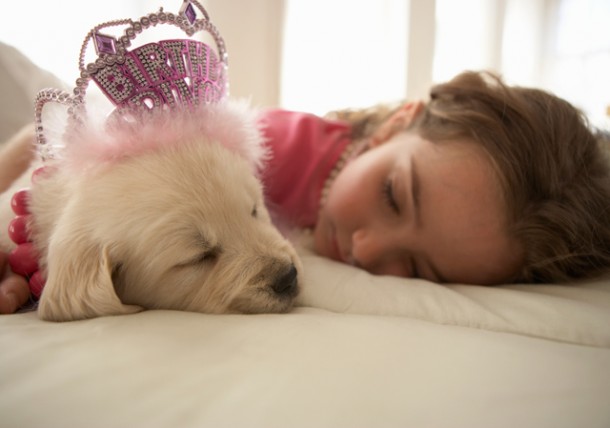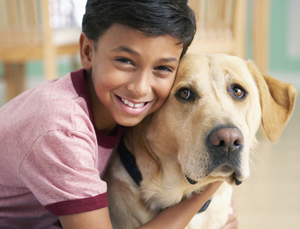Interactions Between Dogs and Kids

There is nothing that warms the heart more than watching your kids and dog romp happily in play, knowing that they will grow up as best buddies. Children can learn so much from caring for and living with a dog. Much of this bonding comes from parents training both their kids and their pets on how to interact and behave with each other. We work hard to teach our children to be polite with others, to say “please” and “thank you,” to share and take turns and to avoid pushing, teasing and bullying; we must do the same when teaching them to interact with our pets.
Why Should We Monitor Interactions between Dogs and Kids?
Unfortunately, there are more than 800,000 cases of dogs biting humans each year, and the vast majority of those involve the family canine biting a child. To many parents, these injuries seem to happen out of the blue and occur when the parent is supervising the interactions between them. So what gives?

While this child looks happy, this dog does not. Teach children to leave a dog alone if it is showing signs of discomfort like this one is.
Most dogs are extremely patient and do their best to avoid biting a family member. However, we humans are not always so good at interpreting the clues that our dogs are communicating to us. Our pet may be communicating, “HELP! Please rescue me from this situation!” But we don’t pick up on these signals of distress.
Signs of Distress When Kids Interact with Dogs
So what should you do to ensure a long and happy relationship between your kids and your dogs? Interactions between children and dogs should be supervised. These are some things to watch for, so you know when to intervene:
- Make sure your child is polite. He or she probably doesn’t like it if someone steals food from his plate. Dogs do not like it if someone messes with the food in their bowl while they are eating.
- No one likes to be awakened from a restful nap or night’s sleep. This is true for human adults, children and dogs. Everybody needs to know that if they are in their sleeping place, they are to be left alone. Dogs should have a safe place they know they can go to be alone and rest, such as a kennel, a bed or a blanket in the corner. Children should be taught that when a dog is resting in its spot, it is to be left alone.
- Children dislike having toys grabbed away from them while they are playing. If your dog is playing with its favorite chew toy or stuffed animal, a child may trigger an aggressive act if he or she grabs it away.
- Children dislike to have their hair pulled, their cheeks pinched or to listen to loud screaming. Likewise, dogs don’t enjoy having their ears or tail pulled, being sat upon or climbed on, being hugged, or loud, screeching noises. Even a small child may pinch a muscle or cause accidental pain, triggering a pet to bite.
- Instruct your children to avoid getting their faces near the dog’s (e.g., for dog “kisses,” etc.) as this may cause them to bite.
- Dogs also must learn manners; this is not a one-way street! They should be taught basic obedience commands. Once they know these, even a young child can ask a dog to sit and then reward the behavior with a treat.
- Playing fetch, going on walks and teaching tricks are great ways for kids and dogs to interact. Fun ways to tire out a child and a dog—a twofer!
- While supervising playtime between your child and your dog, observe your dog’s reactions and body language. You want to see a happy, relaxed pet. If a dog is stiff or frozen in place, it’s not having fun. If a dog’s been panting and then stops as if it’s holding its breath, you need to intervene. These are possible early signs that the canine is uncomfortable with the situation.
- Other signals of imminent problems include yawning outside of context (yawning upon arising or as naptime approaches is normal; yawning at play is not), the whites of the eyes being readily apparent or licking or smacking of lips (unless eating or getting a treat). Erected ears may indicate interest or curious anticipation, but ears flattened against the head can suggest submission or anger. Interpretation of signs should always consider the expression of the entire body. For example, a wagging tail generally suggests well-being or contentment, but a stressed facial expression and flattened ears along with tail-wagging may indicate nervousness and should warn against continuing the activity or approach. Separate your child and dog immediately. Human smiles don’t always indicate a state of happiness, nor should wagging tails.
- If your dog is trying to move away from your child, interrupt your child to stop her or him from following. Your pet is doing his best to avoid a confrontation. If you don’t intervene now, your dog’s next choice may be to growl, snap or bite to make your child stop.
The more you can do to reward positive interactions between your child and your dog, the more likely it is that your dog will overlook or forgive occasional lapses on your part or that of your child. Learn how to read your pet’s body language and teach your children. There is nothing more heartwarming than the bond that develops between a boy or girl and a dog. And we all want that to last for a lifetime.
Lori Teller, DVM is a graduate of Texas A&M College of Veterinary Medicine and lives in Houston, Texas. She practices at Meyerland Animal Clinic.

